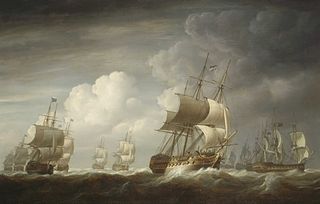Earl Spencer was an East Indiaman, launched in 1795 for the British East India Company (EIC). She made seven voyages for the EIC until in 1811-12 the government took her up to transport convicts to Australia in 1813. On her return voyage from Australia she sailed via China, where she carried a cargo back to England for the EIC.
Henry Dundas was an East Indiaman launched in 1786 that made six voyages for the British East India Company (EIC). She was broken up in 1804.
Northumberland was launched in 1805. She made six voyages as an extra ship of the British East India Company (EIC), between 1805 and 1818. In 1810 and 1811 she served as a transport in the British invasions of Mauritius and Java. She was sold for breaking up in 1819.

Northumberland was launched in 1780 to serve as a regular ship of the British East India Company (EIC). She made six voyages for the EIC between 1780 and 1797. She was sold in 1797 for breaking up.
Earl Talbot was launched as an East Indiaman in 1778. She made six voyages for the British East India Company (EIC) between 1779 and 1793. She was sold for breaking up in 1793.
Hugh Inglis was launched in 1799 as an East Indiaman. She made seven voyages for the British East India Company (EIC), between 1800 and 1817. In 1810 and 1811 she participated as a transport in two British military campaigns. She was sold for breaking up in 1817.
Lord Castlereagh was launched on the Thames in 1802 as an East Indiaman She made seven voyages for the British East India Company (EIC) before she was sold in 1820. She then may have sailed one or twice to Bombay under license from the EIC. Her subsequent disposition is currently obscure.
Lord Camden was launched in 1783 as an East Indiaman for the British East India Company. She made five voyages for the EIC before her owner sold her.

Lord Hawkesbury was launched in 1787 as an East Indiaman for the British East India Company (EIC). She made eight voyages for the EIC before she was sold in 1808 for breaking up.

Lord Macartney was launched in 1782 as an East Indiaman. She made six voyages for the British East India Company (EIC0 before she was sold in 1798. She then traded across the Atlantic to North America and was last listed in 1811.
Earl of Wycombe was launched in 1786 as an East Indiaman. She made six voyages for the British East India Company (EIC). In 1800 she became a general trader, trading across the Atlantic to the West Indies and Canada. She was lost without a trace c.1803.
Deptford was launched in 1781 as an East Indiaman. She made six apparently uneventful voyages for the British East India Company (EIC) before she was sold in 1807 for breaking up.
Lady Jane Dundas was launched in 1800 as an East Indiaman. She made four voyages for the British East India Company (EIC) and was lost in 1809 on the homeward-bound leg of her fifth voyage. She and three other Indiamen parted from the homeward-bound convoy during a gale on 18 March 1809 and were never seen again.

Lady Castlereagh was launched in 1803. She made six apparently uneventful voyages to India and one to China for the British East India Company (EIC). She left the EIC's service and made one voyage transporting convicts to Australia. She was returning from having delivered her convicts to Port Jackson and Van Diemen's Land when she was damaged in October 1818 a gale at Madras. She was surveyed there, condemned, and sold for breaking up.
Worcester was launched in 1785 as an East Indiaman for the British East India Company (EIC). She made eight voyages to India and China for the EIC and participated as a transport in two naval expeditions before she was sold in 1809 for breaking up.
Walpole was launched on the Thames in 1779. She made seven voyages for the British East India Company (EIC). On sixth voyage, on her way to China, her captain discovered an island that he named Walpole Island. She was sold for breaking up in 1799.
Walthamstow was launched in December 1799 in Rotherhithe. She made six voyages for the British East India Company (EIC). She was sold in 1814 for breaking up.

Thomas Grenville was an East Indiaman launched at the Bombay Dockyard for the British East India Company (EIC), and one of only a handful of East Indiamen that it actually owned. She made 14 voyages for the EIC. It sold her in 1834 when it gave up its maritime activities. She was sold for a free trader and burnt in Bombay in June 1843 in a suspicious fire.
Warren Hastings was launched in 1781 as an East Indiaman for the British East India Company (EIC). She made six voyages for the EIC before being sold in 1797 for breaking up.
Lord Duncan was launched on the River Thames in 1798 as an East Indiaman. She made seven voyages for the British East India Company (EIC) before she was sold in 1813 for breaking up.




